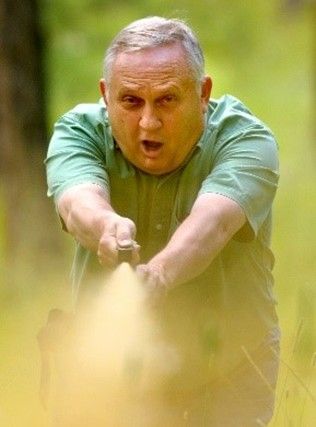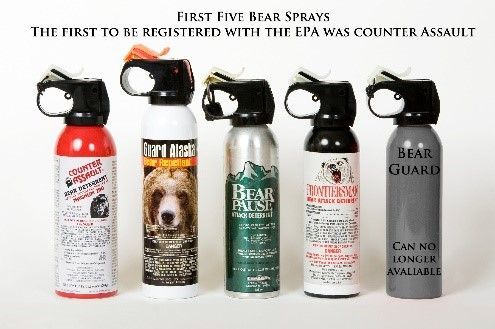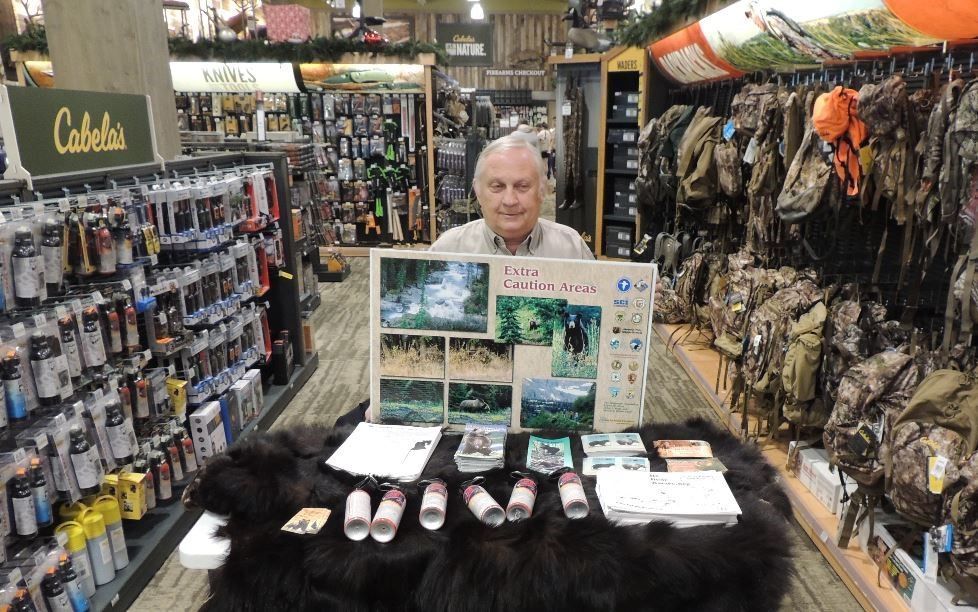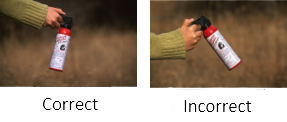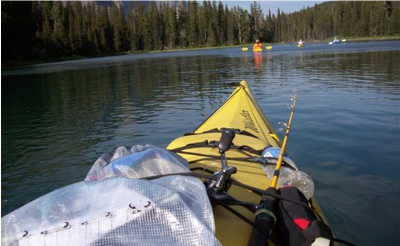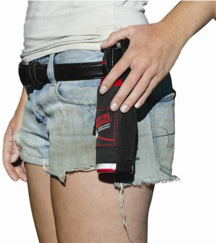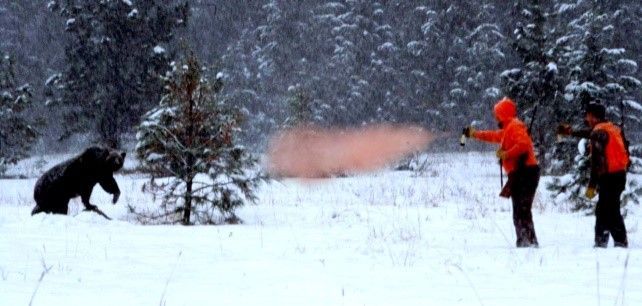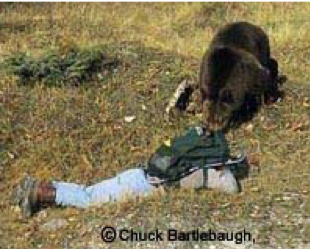Bear Spray
Bear spray is a successful deterrent of agitated charging bears. It is strongly recommended that every person recreating, camping, fishing, or hunting in bear country carry at least one cannister of bear spray. When purchasing your bear spray, it is important to be an informed consumer as not all bear sprays are the same.
Unfortunately, there is a wide variety of bear sprays on the market. Some spray for a mere four seconds; too short of a time to adjust for wind, rain, cold, multiple bears, or one intent on making contact. Others only spray for 15 feet; which places a charging bear, potentially charging upwards of 30 miles per hour, too close to feel the effects of the Capsaicin and related Capsaicinoids before making physical contact.
Our bear spray recommendation is to carry a bear spray that will spray for at least seven seconds and go 30 or more feet in distance. This enables someone to spray a charging bear while it is within 60 feet so ideally the bear and the bear spray cloud meet at a point 30 feet away.
We have broken down how to deploy your bear spray into three categories below in the "How and When to Use Bear Spray" section: It covers bear charges from within 60 feet, 30 feet from a berry patch or near a trail, and 15 feet from a day bed or brushy area. Knowing the distance your bear spray goes is important. How you deploy it is determined by the bear's agitation level and how far away it is.
Additional information can be found in our PowerPoint presentation and downloadable bear spray guide using the links here
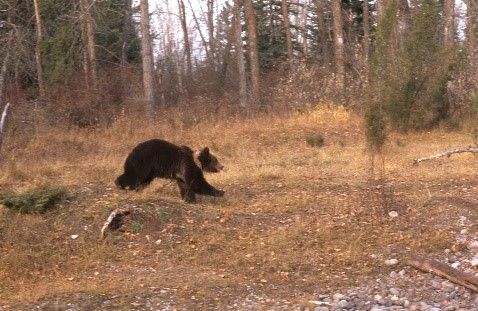
1) What Is Bear Spray?
In the mid-1980s Carrie Hunt, a graduate student at the University of Montana, conducted experiments to see what may stop a charging grizzly bear. When she tested personal defense sprays and law enforcement/military pepper sprays, she found potential but also obstacles to overcome for effective use on bears. Her research led to an understanding of what the active ingredients in bear spray needed to be, and how it worked in different charging bear scenarios. A volunteer to the project, Bill Pounds, successfully developed a concentrated formulation that was well-atomized and able to be dispersed in a powerful, expanding cone-shaped cloud that did not require aiming. Their bear spray could discharge for more than seven seconds, spray 30 feet, and be deployed by simply directing the spray downward in front of the charging bear. These results were a breakthrough that began the bear spray industry; and has saved the lives of people and bears.
The Be Bear Aware Campaign strictly believes in the University of Montana's original standards for bear spray. Their recommendations are to ensure sufficient protection in a variety of bear charge/attack situations such as:
More than one bear charging/attacking from different directions;
Repeated charges/attacks by the same bear;
Defending yourself after spraying a bear that has attacked someone else in your party;
Exceptionally aggressive bears (a mother with cubs, or a bear protecting a fresh kill);
To compensate for weather conditions such as wind, rain and cold;
Erratic spraying due to the fear factor of the situation; and
Reserve spray for the hike out after a charge or attack.
Bear Spray plays an important part in reducing attacks during human encounters with bears. It is a good last line of defense, but it is not a substitute for vigilance and it does not replace appropriate safety techniques.
Bear spray should only be used if you are charged by a bear or other wild animal. It is not intended to be used on non-threatening wildlife. Whenever possible, give the bear a chance to leave, or for you to attempt to leave the area. Never spray yourself, your clothing, or your tent - doing so could actually attract a bear to the scent. You should also be aware that bear spray has its limitations as well - it can be adversely affected by rain, wind, cold temperatures, and how close or aggressive the bear is.
When purchasing bear spray it is important to remember that personal defense sprays are not the same. Although both types of sprays are made from Oleoresin Capsicum, it is the Capsaicin and related Capsaicinoids that are the active ingredients in bear spray. Therefore, if you see claims on a can that state 10%, 20% or 30% Oleoresin Capsicum, it is a personal defense spray, not bear spray. These numbers do not indicate the amount of active ingredients of Capsaicin and related Capsaicinoids.
Bear sprays and bear spray marketing in retail outlets are regulated by the Environmental Protection Agency. Bear sprays require an EPA registration number and establishment number, usually found at the bottom of the front label. Also, bear spray labels must clearly refer to bears, and state it is a bear deterrent, bear repellent, or for stopping attacking bears. Only bear sprays are allowed to have this information.
Currently the EPA requires that the concentration of Capsaicin and related Capsaicinoids range between 1% and 2%. The variance in potency within this range is negligible, and all will cause inflammatory and irritating effects to the mouth, throat, nose, lungs, eyes, and ears of a bear. The active ingredients will severely affect the bear's ability to inhale and exhale enough oxygen to support a charge or attack. The minimum size can the EPA will register is 7.9 ounces, or 225 grams. Cans smaller than this may not have sufficient spray duration or distance to be used safely in deterring a charging bear.
Not all bear sprays are the same in terms of formulation quality, spray duration time, and spray distance. Not all bear sprays will work in cold temperatures. Be sure to read labels to ensure you know what you are buying and what protection value you can expect from it.
2) Bear Spray vs. Pepper Spray
Pepper spray is NOT bear spray and the two should never be compared as being a bear deterrent.
Bear spray is a non-lethal bear deterrent. Its active ingredients, Capsaicin and related Capsaicinoids, cause a bear irritation and an inflammatory response in its mouth, nose, eyes, nasal passage, throat, and lungs and obstructs the bear from being able to inhale and exhale deeply to support its charge.
Bear spray is regulated and its ingredients must be registered with the Environmental Protection Agency (EPA). The formulation and ingredients cannot be altered without being re-registered with the EPA. The EPA does not endorse, test, or verify the effectiveness of bear spray on bears.
The EPA does monitor labeling, advertising, and marketing of bear spray for accuracy and proper terminology. The EPA is not allowed to monitor the internet, websites, YouTube or social media platforms for false claims or inaccuracies. These social media networks did not exist when Congress gave the EPA the authority via the Federal Insecticide, Fungicide, and Rodenticide Act (FIRFA).
Always call it Bear Spray to alleviate continued consumer confusion.
Pepper spray is not allowed to be sold for use on bears. There is no agency that they are required to register their ingredients with. Manufacturers are able to alter their formulation at will on any given day without notifying anyone. Some pepper sprays are very weak and some are overly strong and may harm humans and bears.
Because the EPA is not empowered to monitor websites and social media, some pepper spray manufacturers co-mingle bear spray and pepper spray leading to false information that appears to apply to bear spray when in fact it just applies to pepper spray. Claims of being the hottest, “like hitting a brick wall”, or a shotgun blast may appear on pepper spray but are not allowed on bear spray.
Unfortunately, a lot of people are given incorrect instructions on how to use bear spray based on how to use pepper spray on humans. This incorrect guidance has corrupted information found on the internet and in the media resulting in people being mauled and the false belief that bear spray doesn’t work. Quality bear sprays do work when used correctly; but pepper sprays may not.
3) How & When to Use Bear Spray
Never intentionally approach a bear, or allow it to approach you, because you think your bear spray will keep you safe. Avoid spraying a passive bear to try to get it to leave the area - you may cause it to charge. If the bear is at an established food site, fruit tree, garden, etc., it will often return after about an hour. Bear spray is only meant to be used on charging or attacking bears.
It is crucial that if you need to deploy your bear spray on a charging bear that you are prepared to react spontaneously. This takes practice before you are nervous from an actual charging bear situation. When removing the safety clip, be sure to place your thumb in front of the curled lip and then pull back. As you do so, hold the canister firmly so that it doesn't tilt up when you deploy the spray. Remember, you do not have to aim your bear spray, just direct it slightly downward in front of the charging bear.
Please practice taking out your bear spray and removing the safety clip so it becomes second nature to you. Highly agitated charging bears can run upward of 30 miles per hour and still very fast at short distances. You need to be able to deploy your bear spray without hesitation.
Where you carry your bear spray is also crucial. It should be worn in a place that is readily accessible: on your hip, in a chest or waistband holster, or an outer winter coat pocket. Never place bear spray inside your backpack or a place that will take time to get to it.
To help avoid very close encounters, always pause when the trail enters thick brush, especially near berry patches and streams. Stop, look around, smell the air to determine if there is a pungent smell of dead animal or a bear that's been rolling in one. Call out in a non-threatening middle tone voice to let bears know you are there. Sometimes a bear will stand up to identify you, make itself seen, charge, or just leave the area. Proceed cautiously on a trail that goes through thick brush or when you approach the berry patch to pick your berries. In these situations, have your bear spray out with the safety clip off to be prepared for a sudden, unexpected encounter or charge.
Bear Charge from a Distance - Within 60 Feet
Start spraying once an agitated charging bear is within 60 feet. The charging bear and the bear spray cloud will meet at about 30 feet. Bear spray has a high success rate of stopping charging bears before contact when the bear spray is deployed at this distance. Spray downward to a point approximately 30 feet in front of you. The spray will billow up expanding into a wall of spray the bear must pass through before it gets to you. If the bear veers its charge to the right or left, redirect your bear spray toward the bear's new path. At this distance, there is enough time for the bear to feel the full effects of the bear spray and divert its charge before making contact.
If the bear continues to charge, spray at the front of the bear (because of the expanding cloud, there is no reason to try to aim at the face or eyes). Continue spraying until the bear either breaks off its charge or is going to make contact. If it is a grizzly bear and it's going to make contact, drop to the ground and play dead to give the spray time to take effect. If it is a black bear, prepare to fight aggressively with any available weapons (fists, sticks, rocks, etc.) until the spray has time to take effect. Bear spray has been shown to reduce the length and severity of maulings.
Bear Charge from Within 30 Feet
If a bear charges from within 30 feet, start spraying immediately. Ideally the charging bear will meet the bear spray cloud at 15 feet. Most charges take place with the bear charging from approximately 30 feet. This often happens when a bear is at a berry patch, or, near a trail and is surprised by hikers.
Immediately deploy your bear spray downward directly toward the front of the bear. Continue spraying until the bear either diverts its charge, or appears that it is going to make contact before it fully feels the effects of the bear spray.
If you think the bear is going to make contact, pivot around and drop face down, protecting the back of your neck by clasping your fingers together while still holding the bear spray in one hand. Keep spraying upward, putting yourself and the attacking bear in a cloud of bear spray. The bear will not want to stay in that cloud and will stop its attack and leave. This situ¬ation often results in the bear slapping or biting the person on the ground. If you are wearing a backpack, the pack often takes the brunt of the attack. If the bear rolls you over, keep rolling until you are on your stomach again.
If you are hiking with friends, they should also spray the bear at the point of contact. However, they need to be prepared for the bear to charge at them next.
Sudden Impact - From less than 15 feet away
Sometimes without warning bears in thick brush or concealed in a day bed will charge and often make contact before you even have a chance to remove bear spray from the holster. In these cases, as soon as you can, get your bear spray out and start spraying the area you and the bear are in. If you can, direct the bear spray toward the mouth, nose, eyes, and ears of the bear. The bear may be shaking you or dragging you. If you can, try to get face down to protect your neck, face and other vital organs. Clasp your hands behind your head, holding the bear spray can, and spray, further putting the bear and you under a cloud of bear spray. If the bear rolls you over, continue rolling until you are on your stomach again.
Hiking Partner and Contact with Bear
When hiking with a friend and a charging bear suddenly takes one of you down, there is no time to hesitate. You need to immediately start spraying both the person and the bear. Continue spraying until the bear stops its attack. Be prepared for the bear to change its attack to the person spraying. Continue spraying downward at the front of the bear until it diverts its charge. This is one of the reasons we recommend everyone have their own can of bear spray that provides at least seven seconds of spray duration and 30 feet or more of spray distance.
4) Effects Of Bear Spray On Bears
Charging bears inhale and exhale deeply as they run. When a charging bear meets the bear spray cloud, they breathe in the Capsaicin and related Capsaicinoids (the active ingredients in bear spray) which causes an inflammatory response that irritates and distracts the bear from its charge.
Bear spray effects the bear's mouth, throat, nose, lungs, eyes, and ears almost immediately. The bear's mouth will salivate and its throat will become narrow and irritated causing the bear to cough and choke in response. The bear's nasal passages swell and narrow, disabling its sense of smell and limiting air flow to the lungs. The bears eyes become watery and blurred and its ears begin to ring reducing both sight and hearing.
All of the effects of bear spray are temporary; and are meant to cause the bear to divert its charge or stop its contact.
5) Can Bear Spray Be Used On Other Wild Animals?
6) WE LOVE COUNTER ASSAULT BEAR SPRAY
The Be Bear Aware Campaign is proud to endorse Counter Assault Bear Spray. Counter Assault is the leader in the bear spray industry - they created bear spray, was the first to go to market, and the first to be registered with the Environmental Protection Agency. Most importantly, Counter Assault produces an effective, high-quality, aerosol bear spray that everyone who lives and recreates in bear country should carry.
The Be Bear Aware Campaign is often asked what kind of bear spray we carry, or, what kind of bear spray should I buy. We unequivocally tell them that Counter Assault is the only bear spray we carry or recommend. Here are our reasons why:
1. Bill Pounds, the founder of Counter Assault, was instrumental to the research, development, and production of bear spray. Particularly including formulary ingredients, the nozzle design, and manufacturing. Along the way, he teamed up with Carrie Hunt who was doing her own undergraduate thesis at the University of Montana on ways to stop charging bears. Together they made history – the first aerosol bear spray capable of consistently diverting the charge of a highly agitated bear. It took years to go from concept to retail stores and the Be Bear Aware Campaign was given the opportunity to observe and review various stages of this progression.
2. Counter Assault bear spray is a high-quality product. It comes premixed, which means that it will continuously spray the active ingredients, Capsaicin and Related Capsaicinoids, from the first second through the last. This creates a continuous cloud of active ingredients for the bear or other aggressive animal to run through.
3. They meet and greatly exceed the recommended minimum requirements of 25-foot spray distance and 7 seconds spray duration. Counter Assault has the only bear spray product that sprays 40 feet and has 8 seconds of spray duration. Even more stopping power than before.
4. Counter Assault uses the highest amount of active ingredients allowed by law – 2% Capsaicin and Related Capsaicinoids. The EPA’s rule is one to two percent; but we prefer maximum strength for a potential life or death situation.
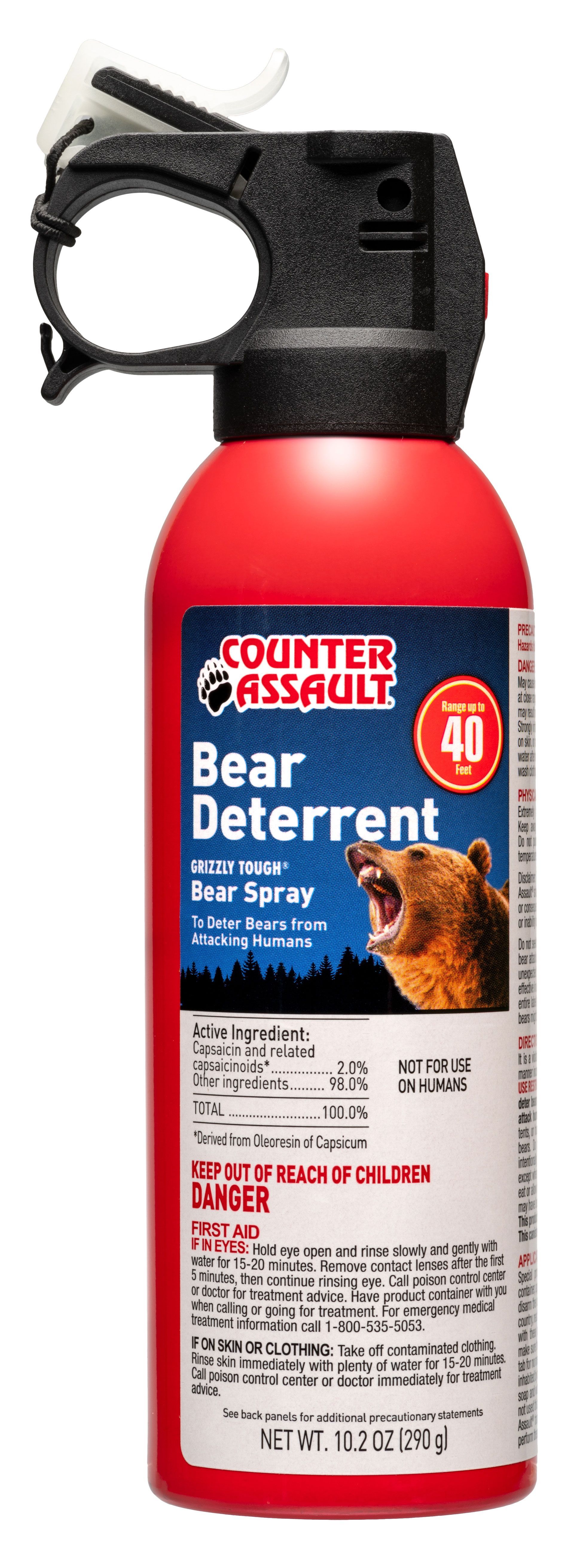
5. Counter Assault’s nozzle system eliminates the need to aim bear spray. Instead of a stream like most pepper sprays, their bear spray nozzle projects a well atomized, powerful, cone-shaped expanding cloud of bear spray. All you have to do is direct it slightly downward towards the front of the bear or other aggressive wildlife. The bear spray will quickly expand and engulf the aggressive or charging animal with the active ingredients, Capsaicin and Related Capsaicinoids. Once the bear spray starts affecting all of the animal’s senses and its ability to breathe in and exhale deeply, it will divert its charge or attack.
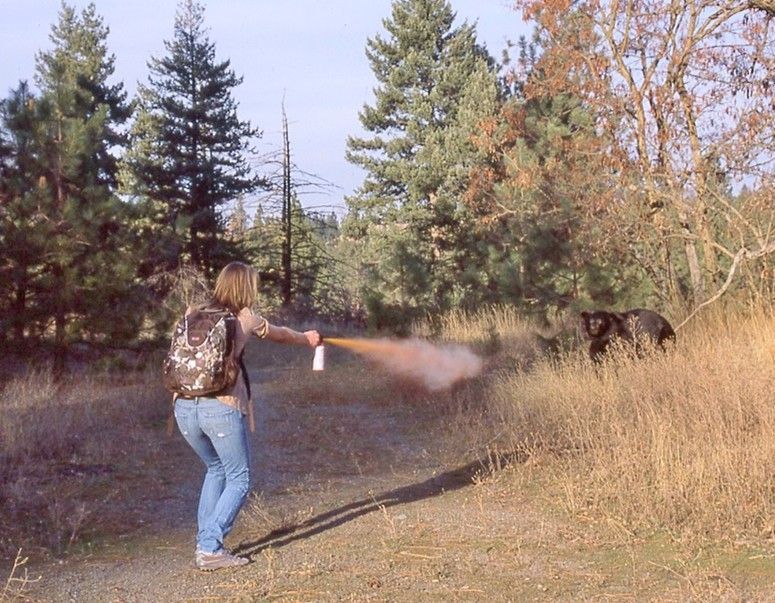
6. Our research of bear encounters and bear spray has provided anecdotal information that Counter Assault bear spray works on more than just bears. People have reported using bear spray on mountain lions, coyotes and wolves, moose, and even aggressive deer, elk, mountain goats and big horn sheep. In fact, bear spray can affect any mammal by irritating and inflaming nasal passages, mouth, throat, lungs, eyes, and ears.
7. On two occasions I had to defend myself against a highly agitated charging bear. My Counter Assault bear spray worked each time.
The Be Bear Aware Campaign has a 40+ year long history of monitoring people’s actions around wildlife, media propaganda, and especially bear encounters and the use and effectiveness of some bear spray.
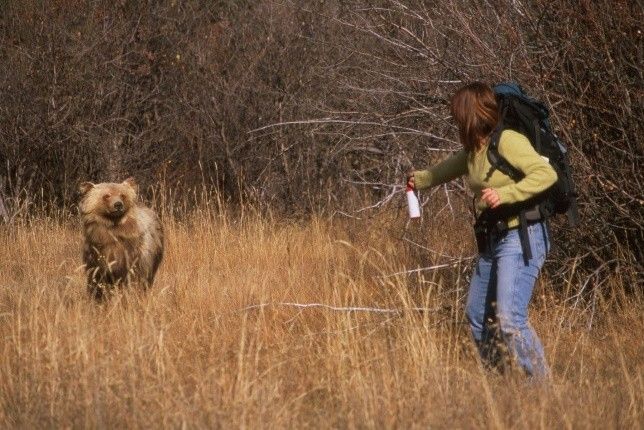
We were there in the early 1980s when Bill Pounds, founder of Counter Assault, and Carrie Hunt, now a renowned wildlife biologist, teamed up to create a non-lethal way to deter highly agitated charging bears. We keenly watched as other pepper and bear spray manufacturers entered the market. We paid particular attention to the instructions, performance claims, and misinformation that was being provided to consumers about the use and effectiveness of bear spray.
The Be Bear Aware Campaign was invited to work with the U.S. Environmental Protection Agency in Washington DC to assist with the development of their educational brochure on bear spray. We were also invited to participate in the EPA’s Regional Convention in Montana with a special presentation about bear spray and its importance for protecting the public.
Congress gave the Environmental Protection the authority to regulate bear spray. When the regulations were enacted, many supposed bear spray manufacturers left the market; some of the others that stayed in were fined heavily for providing misinformation to consumers and faulty products.
We are impressed by Counter Assault’s integrity and leadership, and appreciate that they are also an eco-friendly company.
Last but not least, the Be Bear Aware Campaign and Counter Assault share the same
motto: Safety for People and Safety for Bears and Other Wildlife.
7) First Aid for Exposure to Bear Spray
If Inhaled: Move away from the spray area to where you can get fresh air.
In the Eyes: Hold eyes open and rinse slowly with cold water for 15 to 20 minutes. If you wear contact lenses, rinse for 5 minutes before removing and then continue rinsing. If water is not available, blink eyes repeatedly and do not rub.
On Skin or Clothing: Remove contaminated clothing and rinse skin with cold water for 15 to 20 minutes. A non-oil based mild soap or detergent can be used to remove bear spray from skin. Pat dry with a towel; do not rub.
If Ingested: Do not induce vomiting.
Post Exposure Monitoring: It will take about 45 minutes for the effects to dissipate. Watch for chest pain, cold sweat, or shallow breathing. Asthma sufferers may experience acute stress. Seek medical attention in these situations.
8) Beware Of Misinformation
Misinformation about bear sprays are everywhere you may look. Google snippets, internet searches, websites, Wikipedia, marketing claims, and even unknowingly by retailers, bear biologists, park rangers, and game wardens.
Myth: Measure wind direction before spraying
Fact: In most situations, a bear can reach you in less than 2 seconds if charging full speed. There is no time to measure the wind. Spray spontaneously, directly at the front of the bear and monitor if the wind is affecting the spray.
Myth: Spray a short burst or in a zigzag pattern
Fact: A short burst may not stop an agitated, aggressive charging bear. The inertia and momentum of a short burst or zigzag pattern will only be a fraction of the 30+ feet needed for the bear to feel the full effects of the spray. You want a wall of spray between you and a charging bear. Spray directly at the front of the bear until it diverts its charge.
Myth: You should aim at the bear's face
Fact: Aiming takes too much time and means you are waiting until the bear is close enough to aim directly at the bear's mouth, nose and eyes. This is dangerous and definitely not needed. The objective of bear spray is for the expanding cloud to reach the bear at a distance so that it has time to feel the effects of the bear spray and divert its charge before it reaches you.
Myth: Bear spray works instantly, "like hitting a brick wall"
Fact: Every bear encounter is different. How fast the bear responds to the bear spray may depend on how fast it is travelling or how agitated it is. It may also depend upon whether the bear is just startled or whether it is defending a cub or food source. If a bear charges from close range, even if it is sprayed, its momentum may still carry it into the person.
Myth: Pepper spray and bear spray are the same
Fact: No, pepper spray is NOT bear spray.
Bear spray is required to be registered with the Environmental Protection Agency. Pepper spray is not. Bear spray active ingredients must be 1%-2% Capsaicin and related Capsaicinoids, a derivative of Oleoresin Capsicum found in pepper sprays. The EPA requires bear spray labels to clearly state it is for deterring or repelling bears or for use on attacking bears. All bear sprays must have an EPA registration number and manufacturer number on the can. Bear sprays disperse a powerful, expanding cloud; whereas pepper spray shoots a short narrow stream that must be aimed directly at the face. Unfortunately, original instructions for use were based on pepper spray use on humans and this has corrupted information found on the internet and in the media resulting in people being mauled and the false belief that bear spray doesn't work. Quality bear sprays do work when used correctly; but pepper sprays may not, especially if they are palm-sized.
Myth: Hotter is better
Fact: The Environmental Protection Agency does not allow this unreliable promotional claim on bear spray labels, store displays, or promotional materials. The EPA requires the active ingredients in bear spray to be Capsaicin and related Capsaicinoids and has set the range between 1%-2%.
Myth: The more Oleoresin Capsicum the better
Fact: Oleoresin Capsicum (OC) is simply the oil that contains the Capsaicin and related Capsaicinoids. More Oleoresin Capsicum (oil) requires more solvent to produce the fine, atomized cloud. This reduces space in the can for propellant and may reduce the spray duration and distance. More OC may cause a thicker spray separating the active ingredients from the propellant causing it to fall to the ground. It can also clog the spray nozzle causing erratic spraying.
Myth: Bear spray cans that empty faster are better
Fact: Bear spray that is dispersed too fast will only waste vital spray. Spray cans that deploy fast do not intensify the power of the bear spray or its active ingredients. Bear spray is already designed to powerfully discharge and quickly reach 30 or more feet in distance. A fast dispersing spray does not allow you to compensate for more than one charge or charges by multiple bears. You also need spray time in order to accommodate weather variables such as wind, rain, and extreme cold as well as other unforeseen factors. Hopefully, you will also have spray available for your hike out.
Myth: If you have bear spray you can approach bears
Fact: You should never approach or interact with bears. There are regulations governing against the harassment of wildlife, especially bears, and you are still required to follow all wildlife regulations.
9) Does Bear Spray Work?
THIS SPECIAL SECTION CONTAINS ARTICLES THAT MAKE COMMON MISTAKES ABOUT BEAR SPRAY. They insinuate all bear sprays are the same – they are not. In addition, pepper spray is often used instead of bear spray and it is not legal to be sold as a bear spray. Without clarifying these claims, much of what is listed below can mislead consumers. Further, the instructions for bear spray that are given out are often inadequate and misleading. Please read with caution.
The Be Bear Aware Campaign has conducted its own study and review of bear spray over the past 30 years, specifically focusing on instances of bear spray use, why it may not have worked in some scenarios, and the false and misleading instructions provided for bear spray use. We conclude that quality bear spray is the most effective deterrent against a highly agitated charging bear. Firearms may be effective against a charging bear, however, you must be very skilled, aiming takes away valuable time, a wounded bear sometimes continues it charge to make contact, and innocent bystanders have been accidentally shot and killed. The Be Bear Aware Campaign promotes the safety standards produced during the research and development at the University of Montana that lead to the creation of bear spray - a spray duration of at least 7+ seconds and a spray distance of at least 30+ feet.
Please always call it bear spray. This is important to help reduce confusion between bear spray and pepper sprays made for personal defense.
1. Research Report - Efficacy of Bear Deterrent Spray in Alaska
(Tom Smith, Stephen Herrero, Terry Debruyn & James Wilder-2008)
2) Bear Spray Fail?
(Craig Medred-September 19, 2018)
3) Bear Ignored Spray
(Craig Medred-June 30, 2017)
4) Bear Spray, Yes or No?
(Craig Medred-June 29, 2017)
5) Double Bear Attack Survivor Interviewed at Shot Show
(Ammoland-February 14, 2018)
6) Was Bear Spray Effective in the Mark Uptain Grizzly Fatality?
(Ammoland-February 14, 2019)
7) Life with Bears
(Craid Medred-May 22, 2017)
8) Another Bear Spray Failure - Bow Hunter Mauled
(September 13, 2017)

